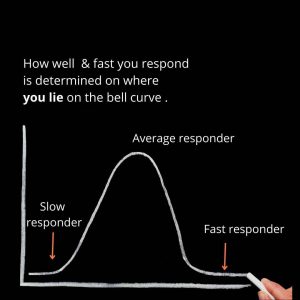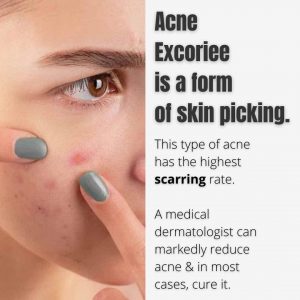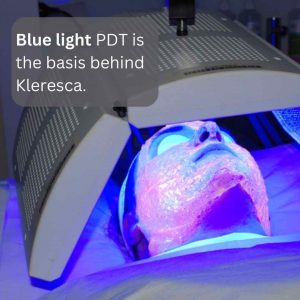3 main factors determine when acne is scarring-
- Acne activity & the time taken to effectively control acne. This is by far the biggest factor. Time to absolute control is defined as the time taken to get zero (orå almost zero) pimples. It is not the time taken to see someone, or give a treatment a go, it is the time taken to remission. Every single week counts.
- Genetics. This refers to your DNA or genes that predispose you to scarring. You can not alter DNA, but you can alter the course of acne.
- Picking. Another factor to consider. If you have zero acne, you won’t pick. In cases of picking acne, your control needs to be absolute- even if you have one zit per month.

Why remission?
Active acne causes skin inflammation. That’s why pimples are red. Skin inflammation, no matter how small, is counterproductive to collagen production & scar remodeling. This means you are much less efficient at repairing scars.

Here is an analogy. You want to get stronger, hence you train hard, eat well. This builds muscle fibers (akin to generating new collagen). Fate has it you get a small injury like a muscle strain. Your body has ZERO chance of building muscles because its efforts are concentrated on reducing inflammation & repairing that part of the muscle over generating new muscle. The same thing happens with active acne. Skin is not interested in collagen regeneration, but extinguishing inflammation due to acne.

What is the definition of remission?
No active acne over a period of 3 months. In patients with scarring, absolute control is advised. When acne is in remission, your skin’s immune system can efficiently remodel scars & regenerate collagen.

How to tell if acne is in remission?
Count the number of spots. This means every single pimple. Never go by how you feel about your acne, go by objective measurements, namely lesion count. As a guide-
- Males age 14-20: up to 10 acne spots per month.
- Males age 20 & above: up to 4 acne lesions per month.
- Females age 14-20: up to 12 acne spots per month
- Females age 20 & above: 3-5 non-scarring spots, mix of jawline & other areas
Whilst the above is just a guide & not absolute, it gives you, the patient, a reference point. An example is if you have a genetic tendency to scar, & or if you pick. In this case, the number of spots per month should be zero.

Use your phone to document progress. Take a series of 5 photos, with good lighting. Remember, document your acne, not your scars. Follow this up with sequential photos every month. Ask someone to count the spots (you can do it as well, just as long as you are objective about things.). Remember, it is not about how YOU feel you are going, it is about an objective assessment of your skin.
What is the term ‘counting scars’?
This refers to the passage of time when your scars accumulate. Here is an example-
5 pimples per month, but only 1 scar (20% scar rate). 12 scars over 1 year, 60 scars over 5 years. Because scarring is a gradual process, you do not notice the progression.
This is another reason why your acne should be in complete remission.

How to place acne in remission?
The best way to place acne in remission is to see a dermatologist. They will ensure that you will receive the best possible treatments for your type of acne. If required, dermatologists will order special tests such as hormonal profiles to investigate the cause of your acne.
You can try other DIY methods as I have covered in greater detail on this website, on YouTube, IG posts & on the Cutis Dermatology website. Just remember the most important prognostic factor to determine scarring is the time taken to absolute control, & not the time taken to try a new anti-acne program.
What treatments will my colleagues initiate to treat acne?
Dermatologists prescribe drugs, not fairy dust. Depending on your history they will prescribe one of the following medications;
Topical retinoids: this group of topicals include tretinoin, retinoic acid & trifarotene. These groups of molecules take 6-16 weeks to achieve their optimal effects.
Oral retinoids: Accutane or isotretinoin. This is the most powerful anti-acne medication. It requires frequent monitoring. Revision guidelines published in 2016 allows most scar revision procedures to be conducted whilst on this medication. Your dermatologist will guide you.
Anti-androgen medications: are great for female patients. This group includes the pill, with drospirenone or cyproterone acetate. Another fav is spironolactone.
Anti-inflammatory antibiotics: they work by reducing bacteria counts. Great for teenage acne, but less useful in adult acne. Why? Because if you stop taking them, your acne will most likely return.
Adjunctive therapy: see below. They include chemical peels, lasers, and phototherapy.

Do you need a referral to see my dermatology colleagues?
Yes. Dermatologists are medical specialists, hence a referral is required. You can obtain one from your GP. If you see me for acne scar revision & have active acne, I will generate a referral for you, saving a visit to your family doctor.
Why do we work with two teams- scar revision team, & acne treatment medical team?
One team is procedural & the other is medical. The latter manages your acne via tablets, topicals & other methods (see below). Both teams are in communication with each other as we share notes & photographs.
The procedural scar revision team will not be involved in managing acne, as follow ups are factored into the equation. This makes it much clearer for the patient & importantly frees up our time to concentrate on scar revision follow ups. The procedural team & me will always work around the medical team, no matter what they prescribe you.

Do I treat acne?
No. My work is entirely procedural. Though I have knowledge in treating all forms of acne, including hormonal, cystic, bacne, PCOS associated acne, comedonal, early onset acne, pregnancy associated acne & acne inversa, treatments fall under the category of medical dermatology. This is beyond my scope of interest.
What scar treatment methods are possible for early acne scars?
Early scars, namely between 2-6 months are typically red or brown, acknowledging that in darker skin types color changes can linger for many years.
A good treatment to remodel & banish early acne scarring is as follows;
Vascular lasers for red scars.
Pico lasers for brown scars.
Hybrid lasers for atrophic scars.
These lasers are performed by my lead nurses & are cost effective. Treatments range from $390 for vascular & pico lasers, CO2 & Hybrid laser resurfacing starts at $690.
CO2 lasers are useful for treating atrophic acne scars only if the atrophy is collagen & not fat.
What is a simple program that is a compromise?
A simple, cost effective program to effectively & efficiently treat older acne scars (scars more than 6 months old), is a combination of-
- Laser CO2 or erbium fractional
- RF microneedling with Genius or Morpheus8
- TCA Paint (if any boxcar or ice pick scars)
- Subcision with cannula
- Tixel
- Picosecond lasers for pigment associated scarring.

The above program is performed by my senior nurses whom I have taught over a period of 7 years. They have performed hundreds of cases, & are cost effective, namely between $690 to $1190 per session (price varies depending on the areas treated & complexity of revision).
They also perform dermal fillers for atrophic scars as well as biostimulatory injectables to boost collagen production.
When do I jump in?
To keep costs down for patients, my scar revision work is limited to the scar combinations below. The caveat? If cost is no issue, I can revise simple scar signatures, however I will advise you accordingly.
- Complex scar types including deep rolling atrophic acne scars.
- Complex surgery such as excision & multi-level sharp dissection & subcision using flared cannulas.
- Complex & deep laser resurfacing
- Hypopigmented scars
- Deep atrophic scars that require fat transfer or high volume fillers
- Subcision in high risk areas such as the jawline, temples & forehead

What if you don’t want any acne management but only want scar revision?
Your face, your money, your call. We can only guide you through the best methods & steps. My team & I will take note of your request & gently remind you of what we think is best for you.
As I have said many times before, I am not fussed as to how you gain absolute acne remission whether it be Accutane or fuzzy fairy dust like rosehip & tea tree oil with zinc tablets. The method is irrelevant as my team is focused on the outcome (no acne).
What are other rate limiting factors to consider?
All things considered, the other two rate limiting factors are-
Age. Collagen loss is seen after the age of 20 at a decline of 1-2% annually. Age 40 & you have 25-30% less collagen than at your peak. This means you need to play catch up the older you are. Additionally your potential to generate new collagen is less with age. In summary-
- The older you are, the more the need for tissue support. In a good number of cases, you will require some assistance to generate collagen, namely collagen stimulating dermal fillers.
- Your immune system is much less efficient at scar remodeling the older you get. The answer? Collagen stimulating dermal fillers. This group of fillers are different from cosmetic fillers (hyaluronic acid) as they generate more collagen compared to volume.
Biology. This is a biggie. Everyone lies on a bell curve. This applies to everything biological. Examples include height, IQ, basal metabolic rate, & in the context of scar revision the ability to regenerate collagen, fat & remodel scars. Those on the right of the curve remodel tissue with zest & speed, those on the left remodel at a much slower rate. You can not modify the natural biological process, however there are things that you can do to help it. This includes-
- Reduce or eliminate all forms of inflammation, again this comes down to absolute control of acne.
- Eat well, don’t smoke. High protein foods, healthy living.
- Helping hand with collagen stimulating fillers.

Insight (or lack of). I understand the importance of scarring & your motivation to address this. My job is to tell it like it is- essentially treat your scars but at the same time give you the best possible outcomes. If you still have active acne (or recent acne that continues to cycle; some good weeks followed by flares), seeing a medical dermatologist will be in your best interest. I can only lead a horse to water…

What can you do to treat acne?
Chances are, if you still have active acne, fluffy things like retinol, niacinamide & salicylic acid washes won’t work, or do not work well enough to gain absolute control.
If you have not tried any of these; a simple solution is-
AM: Salicylic acid wash 2%, SPF
PM: Salicylic acid wash 2%, Retinol 0.1% (or better still Differin)
An anti-acne diet is invaluable, but you can not have cheat days or you will end up chasing your tail. Diet restrictions include no sugar, no refined foods, no dairy products & no fast absorbing protein such as whey. You may see results following this diet at week 2, but it can take up to 10 weeks for best outcomes.

What are other treatment options?
If you are adamant about heart set acne treatments, you have other avenues to take. Ideally these are given by your treating dermatologist. Just a hint; don’t view acne treatments as cosmetic & pick from a menu of possible treatments, be guided by experts. Regardless, here are adjunctive acne treatments-
Chemical peels: The best is salicylic acid. The concentration is 8-15 times higher than BHA washes. Ideally for congested skin, blackheads or as adjuvant therapy to isotretinoin, topical retinoids. Second best is retinoic acid peeling. Concentration is approximately 100 times that of fluff like retinol.
Lasers: Pulse dye laser or KTP laser such as DermaV. These lasers are best for pimples, small cysts, and red marks known as PIE or macular erythema. 2-4 sessions, depending on severity. Spectra Hollywood laser peels are also great, especially in darker skin types.
AviClear is a novel laser specifically employed to target sebaceous glands that are implicated in the development of acne lesions. 3 sessions are required over 3 months. It has a 80% success rate. Be mindful of costs as you need to factor in acne treatments & acne scar revision. Your medical dermatologist will guide you.

LLLT or low level laser therapy. Red & blue light phototherapy is a good method of reducing acne lesions quickly. We have several devices that do this, including blue light BBL or Forever Clear, & light emitting diodes from Healite. LLLT is best used as an adjunctive treatment, it rarely offers a cure or a long term solution.

Are fairy treatments effective in treating acne or acne scarring?
Treatments such as witch hazel, tea tree oil, rosehip oil & other natural remedies have their own benefits & niche. If you have mild non-scarring acne, sure, knock yourself out. If you have acne on the background of scarring, reconsider. Remember the number one predictive factor for scarring is the time taken to effective control (absolute).
Let’s talk about diet. It works in over 60% of cases, that means in 40% of cases it fails. I do encourage you to consider an anti-acne diet, but here is that catch- it is long term with zero cheat days, unlike caloric deficit weight loss diets.

Any other tips to reduce scarring whilst awaiting acne remission?
Some other helpful tips include-
Acne patches. This is useful if you have picking acne. Hydrocolloid patches can be obtained via a pharmacy. They cost $5-$7 a box. They are probably the most effective method of preventing acne scars, especially if you pick.

Skin care. The biggest gains you will make is with sunscreen. It can prevent post inflammatory hyperpigmentation (dark spots) & or PIE or red acne scars.
Listen to your dermatologist. They will guide you accordingly. They have only two goals in mind. Firstly, treat acne & place it into remission. Secondly, do it safely. My colleagues will cut out all the sh*t & glitter & are focused at treating your acne.
Treating early acne scars. Early scars are less than 6 months. If your inflammation is controlled early intervention with minimally invasive treatments can yield astonishing results. Examples- vascular laser for red scars, pico laser for brown scars, Tixel or Co2 fractional for early atrophic acne scars.
Objective assessments. Never go by how you feel about your acne-acne scars, instead base progress objectively.
Accutane: if you have been offered this medication, consider taking it. I don’t prescribe this medication as my interest is not in the management of acne. Having said that, Accutane has the highest rate of clearing, & in many cases (>60%) curing your acne.
Why do I still get acne after Accutane?
Pust simply, you fall under the category of statistics. Your first course has a cure rate of around 60-70%. The flipside? 30-40% require a second course. Of that 20% require a third course. You are just a number.Statistics are applied to everyone. Of course it is more complicated than that as your medical dermatologist will exclude secondary causes of acne including-
- Hormonal acne (real hormonal acne, not the made up ‘hormonal’ acne of adults or female jawline hormonal acne which is really an intracrine condition). This refers to PCOS, high testosterone, 17 Oh progesterone, prolactin from brain tumors etc..
- Drug induced causes; steroids, exogenous hormones, lithium etc…
- Secondary to poor compliance: did you finish the course of Accutane? Was the drug well absorbed to obtain the theoretical threshold?
- RAR (retinoid receptor) or FGF gene anomalies; super super rare, only seen two cases in my career of 20 years.

